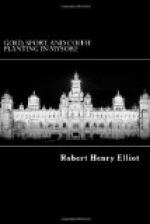[5] After the fall of Seringapatam some further military operations were necessary in Manjarabad, and some of Colonel Wellesley’s letters were written within a few miles of my bungalow.
[6] So called from its flowing from a source which was supposed to have been formed by a stroke of Rama’s arrow.
[7] All travellers are obliged to record their names in these books, and state the time they have stayed, and the sums they have paid for the use of the bungalow.
[8] “Gazetteer of the Bombay Presidency,” vol. xv. Kanara, Bombay. Printed at the Government Central Press, 1883.
[9] The native idea.
[10] “Eastern Experiences,” by L. Bowring, C.S.I.; Henry S. King and Co., London, 1871. Before visiting Mysore the traveller should certainly buy or consult this book.
CHAPTER III.
Mysore—its history, government, and representative assembly.
In my last chapter I gave a description of Mysore and its waterfalls. In the present chapter I purpose very briefly remarking on its history, government, and representative assembly, and shall conclude by contrasting the last with the so-called National Indian Congress.
In his Report of December, 1804, the Acting Resident of Mysore, Colonel Mark Wilks, observed that “the territories composing the present dominion of His Highness the Rajah of Mysore had, from the remotest periods of tradition, been held by a number of polygars and petty Rajahs, whose possessions were incessantly enlarged, diminished, or alienated, by a series of revolutions which it would perhaps be impossible to trace, and unprofitable to describe,” and it is interesting to note how little, at that time, seems to have been known about the history of the kingdoms we conquered. But all doubts as to the early history of Mysore have now been removed, and the reader will find in Mr. Rice’s admirable gazetteer of Mysore a minute history of the country accompanied by coloured maps which show at a glance the numerous transitions which the territories now comprised under the head of Mysore have undergone in former times, but as I think that it would certainly be unprofitable to describe these transitions here I shall content myself with a bare enumeration of those leading facts which are necessary for a general comprehension of the situation. All, then, that the reader requires to know is, that a line of Hindoo Rajahs which once reigned over a very limited portion of Mysore gradually acquired about half of it; that a descendant of their line was set aside by the Mahometan usurper Hyder Ali (an able soldier of fortune, who had risen to the chief command of the army); that he conquered the remainder of the present territory and ruled it from 1761 to 1782; and that after his death he was succeeded by his son Sultan Tippoo, who on May 4th, 1799, lost his life at Seringapatam, and with it all the territories




